For some time, Jill Vialet felt there were deep problems with the substitute teaching system in the United States. Vialet had seen these problems during her years of work as founder and CEO of Playworks, an organization that helps schools and youth programs create recess and play environments for children.
School leaders expressed one immediate, persistent problem: a shortage of substitutes. When a teacher called in sick and a registered substitute was not available, schools had to scramble to find an in-school replacement or move students around to other classrooms—a logistical headache for staff that often led to poor learning experiences. Many schools felt they needed to recruit more substitutes, yet they had precious little time to do so.
The feeling that the US school system could and should rethink and redesign substitute teaching nagged at her, and in Fall of 2015, she determined to take a design approach to tackling the problem.
Vialet learned how the substitute system worked and studied school district data, and was surprised to find that many districts actually had large pools of registered substitutes, or “subs,” who had invested time and effort in becoming certified and enrolling in the program. Yet only a small percentage of registered subs taught on a regular basis, while others subbed only occasionally or not at all. Describing the problem as a “substitute shortage” over-simplified the issue. So why was it so difficult for districts to fill substitute needs from such large sub pools?
Are you enjoying this article? Read more like this, plus SSIR's full archive of content, when you subscribe.
To answer this question, Vialet turned to human-centered design methods, which emphasize first-hand investigation, understanding who you are designing for, and an iterative experimental approach. She started by conducting ethnographic interviews with substitute teachers. Their stories were bleak: Substitutes felt they weren’t respected or valued by schools, and felt they didn’t have a community of support in schools or among their fellow subs. “At best, subs are an afterthought,” said Vialet. “At worst, they’re the butt of a joke.”
She realized her initial impulse to simply recruit and staff more subs would have minimal benefit if the existing sub pool remained underutilized. Staffing substitutes wouldn’t solve a more fundamental issue: the system and experience that greets subs on the job. This shifted Jill’s perspective and directed her efforts toward empowering schools and districts to adapt their own approaches of supporting subs.
Grappling with complex social challenges
Vialet’s challenge—how to redesign K-12 substitute teaching to ensure high-quality learning when regular teachers are absent—is a deeply human one, yet it is also embedded within complex social systems. And her challenge is hardly unique. Rita Nguyen, a past Stanford d.school Civic Innovation Fellow, for example, is working on making access to nutritious food part of US health care and health insurance systems. Jae Rhim Lee, also a past d.school fellow, is working to make burial practices in the United States more environmentally sound in the face of the funeral industry and well-established societal expectations.
Challenges like these require understanding people and their motivations, while taking into account larger issues at play. It is essential to know where to act within a network of different stakeholders and entities to create the greatest benefits. It is also important to know the short- and long-term effectiveness of solutions within the conditions of a particular social system—that is, the full range of human and institutional elements that compose and feed into a given issue, and connections between them.
Adopting a design approach
A design approach emphasizes discovering the right problem to solve, and investing in both problem-finding and problem-solving. For both human- and systems-level challenges, we need to identify the problems worth addressing if we are to create meaningful change. Understanding the right problem, we can better create effective solutions. A very simple characterization of a design approach is that we move from working to understand a challenge, to working on creating solutions in response to the challenge.
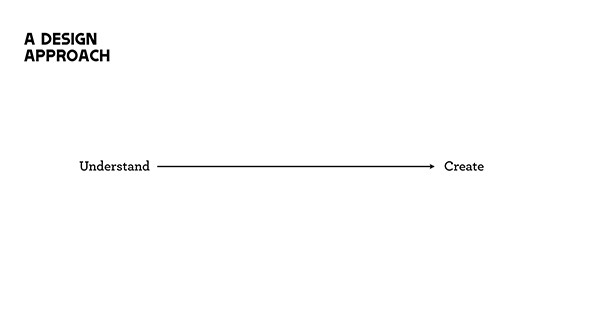 A simple characterization of a design approach.
A simple characterization of a design approach.
To create impactful solutions—and not just incremental change—we need to gain new perspectives on challenges. We need to analyze qualitative and quantitative data for insights that can point us to better opportunities. With new perspectives, we can conceptualize and create more effective solutions.
This work of sense-making is an act of abstraction: We move from the concrete (gathered information and observations) to abstract (a new perspective), and then back to concrete (new solutions). This abstraction helps us achieve new and meaningful viewpoints and solutions, rather than simply jumping to a quick fix for the visible symptoms of a deeper issue.
Combining the emphasis on problem-finding with the need for abstraction, we can create a new visualization of a design approach. (This is an adaptation of a model of Charles Owen’s presented in his 1998 paper “Design, Advanced Planning and Product Development.”)
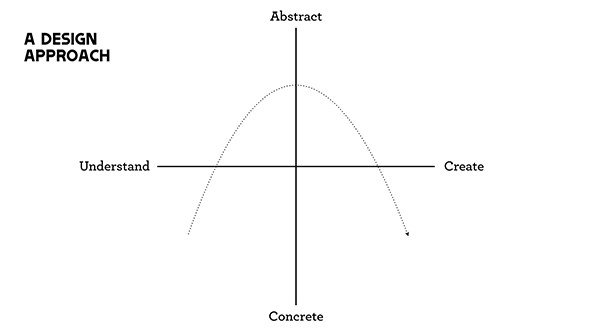 A framework for a design approach. During a project, we generally move through the four quadrants as shown with the dotted line.
A framework for a design approach. During a project, we generally move through the four quadrants as shown with the dotted line.
Our approach is now split into four modes, with one in each quadrant:
- Gathering qualitative and quantitative data (concrete-understanding)
- Making sense of these data to gain insights and a new perspective on the challenge (abstract-understanding)
- Using these insights to inform new opportunities (abstract-creation) and framing what you aim to achieve
- Responding to those opportunities to conceptualize and build new products, services, and systems solutions (concrete-creation)
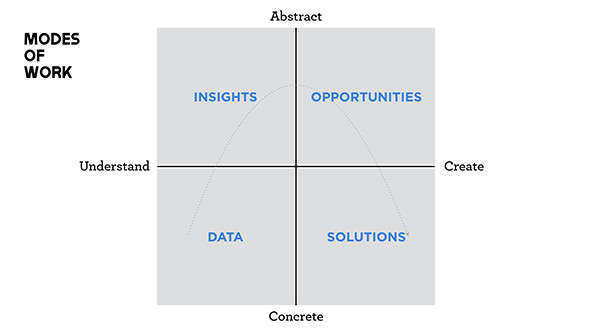 A framework for a design approach. During a project, we generally move through the four quadrants as shown with the dotted line.
A framework for a design approach. During a project, we generally move through the four quadrants as shown with the dotted line.
There are many tools and techniques we can use for each of these modes. Which tool a team selects depends on the challenge at hand. (I will note some typical tools in the coming sections.) Four guiding questions can help frame our work: What do we notice? What’s the meaning? What’s our direction? And what’s our solution?
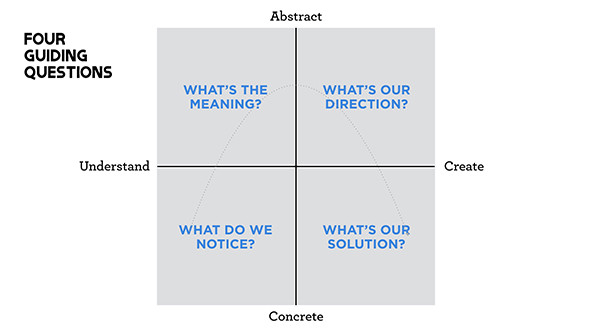 The framework shown with four guiding questions (one in each quadrant) a design approach helps answer.
The framework shown with four guiding questions (one in each quadrant) a design approach helps answer.
Human-centered tools for a design approach
With this frame of a design approach, if we were to advance a project using human-centered methods, we might use this series of tools:
- Obtaining data by interviewing users to gather stories and information
- Unpacking those stories and inferring the meaning to gain insights
- Creating brainstorming questions to describe the design opportunities—we often call these “How Might We” or HMW questions
- Prototyping solutions to make them tangible and testable.
This is a simplified description, naming one common human-centered tool per quadrant. Again, there are many different tools we could use in each of the modes. For example, for data gathering, techniques could include arranged interviews, intercept interviews, participant and non-participant observation, user diaries, cultural probes, and analogous research—just within the practice of qualitative design research alone.
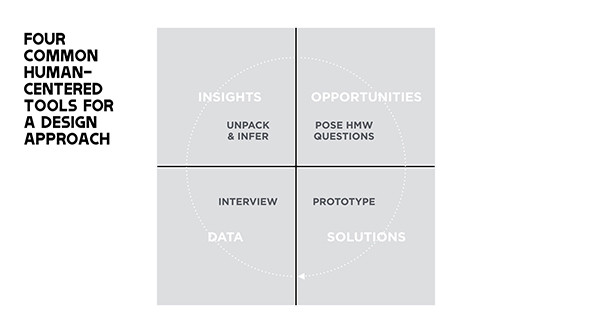 The framework shown with a common, human-centered tool in each quadrant.
The framework shown with a common, human-centered tool in each quadrant.
Imagine a team using human-centered tools to redesign substitute teaching, with a focus on improving the learning experiences delivered by substitutes. The following example reflects one of Vialet’s early design cycles through the four quadrants, including the team’s verbal descriptions of each cycle:
- Data: The team starts by interviewing substitute teachers, day-to-day classroom teachers, and students. They hear a lot about people’s feelings about classes taught by substitutes. “We’re working to improve the teaching of substitutes, so we are talking to subs and students.”
- Insights: The team tries to make sense of all they have learned by unpacking and retelling stories, and getting that information up on a board. They then work to infer new meanings to gain insights and a new perspective. “It’s all about rapport between sub and students. While many subs struggle to gain traction in the classroom, successful ones often put the planned lesson aside and connect with the students (using some go-to tricks they have).”
- Opportunities: They use that new perspective to frame new opportunities for which to design. “How might we help every substitute develop their go-to techniques to gain rapport in the classroom?”
- Solutions: The team can then generate new ideas and test those ideas by prototyping. They create new artifacts and experiences people (i.e. potential users) can react to. “We’re experimenting with a ‘bag-of-tricks’ kit that subs could pull from in the classroom.”
Practitioners consistently achieve high-impact solutions using human-centered design tools. However, a human-centered design approach is most successful when you primarily need to understand and create solutions for the customer or beneficiary of your product, service, or offering. Your task is also easier if you more or less control the implementation of the solution. If you manufacture a product or operate a service yourself, you can focus more on what you are creating, and less on convincing and designing for other stakeholders that impact the group you are trying to serve.
But a human-centered approach has its shortcomings. You might create solutions that address the symptoms of a problem, but in turn overlook opportunities to address root causes of the problem. You could get preoccupied with solving for human needs that are not highly impactful. You might overlook downstream consequences of your creations—not only for your beneficiaries, but also for other stakeholders or society as a whole.
The scope of your project—how deeply you delve into underlying causes—will dictate whether a solely human-centered design approach is appropriate. In the above example, a human-centered design approach might produce a very effective new set of classroom tools for subs, and if subs use them, that could have meaningful results for students. But the team may overlook other factors that more significantly impact learning outcomes when teachers are absent—for example, the difficulty in getting enough skilled and effective substitutes to fill in. That’s a more complex challenge, but one that could become part of the project simply by changing its scope.
Systems thinking tools for a design approach
Social systems problems present a number of difficulties. There are many stakeholders to consider, and a single product or solution won’t likely solve all problems.
Who should you design for? Or better yet, how do you design interventions that create positive ripples throughout a system? Where do you implement your solutions? What solutions will make a dent in the problem, or change conditions so large positive gains can occur? How do you deploy solutions in the system or get stakeholders to take action themselves?
When things are this complex, systems thinking tools can help us strategize. Here are four common systems thinking tools we might use here:
- Obtaining data about the system by researching relevant stakeholders and noting the value exchange between them
- Mapping cause and effect in the system to gain insights about what is enabling or inhibiting the progress we would like to see
- Identifying points of leverage in the system as opportunities where interventions may have outsized effects
- Experimenting with solutions to see if the desired outcomes are created
As with human-centered tools, there are many more systems tools that might be used.
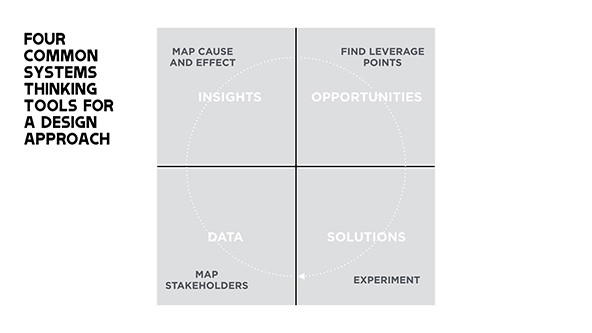 The framework shown with a common systems thinking tool used in each quadrant.
The framework shown with a common systems thinking tool used in each quadrant.
Returning to the subject of substitute teaching: Imagine a team looking at the challenge with a larger scope than simply how well subs teach in the classroom. They may ask: How can we ensure there is always a substitute on hand to fill in for absent teachers? How could substitute teaching be an added benefit to schools, and to learning in general? How might we fundamentally redesign how substitute teaching is implemented in schools?
Imagine the team’s sequence of work using systems thinking tools:
- Data: The team starts by mapping all the stakeholders and entities involved in substitute teaching—subs, day-to-day teachers, the school board, school district officers, HR personnel, parents, students, and so on—and how they relate to one another. “We’re working to redesign substitute teaching, so we are looking at the relationships between players in the system.”
- Insights: The team then maps forces at play in the system to see what factors are positively or negatively affecting outcomes. How might changing one factor impact another? “We see a major issue is a shortage of substitutes, forcing teachers and staff to fill in or principals to redistribute students. This deteriorates classroom learning. The day-to-day reactionary management also leave no time to recruit new subs.”
- Opportunities: Taking into consideration system stakeholders and forces, they assess areas of leverage, evaluating options for how and where in the system to act. “To recruit more substitutes, we could leverage community partners and appeal to a feeling of civic duty of potential subs.”
- Solutions: They strategize interventions and proceed with experiments to test solutions. “A solution could be a third-party organization working with community partners to recruit and staff substitutes.”
For more complex challenges such as the above, the team benefits from the wider lens of systems thinking. They gain insight by looking at relationships in the system to find points of intervention and thus more effective solutions.
But there are potential drawbacks to a systems thinking approach. It can be difficult to see the motivations and actions of particular people within the system, which might be essential to changing human behavior. And it can be more difficult to quickly test initial hunches and assumptions. In a typical systems approach, a team may also jump from their well-thought-out-but-untested-strategy to a pilot. Pilots often aim to show the effectiveness of an intervention at a significant scale. They can test a solution in the true complete conditions of the system, but there is danger in committing extensive resources to an untested solution, and the motive shifts from learning to proving the idea works.
A framework for integrating human-centered and systems-thinking methods
Which brings us to our final point: how human-centered and systems thinking tools and mindsets might complement each other. Here, the eight previously discussed tools are placed together on the framework.
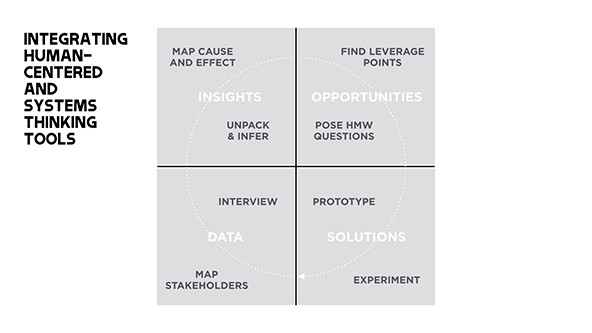 The framework shown with a complementary human-centered and systems thinking tool in each quadrant.
The framework shown with a complementary human-centered and systems thinking tool in each quadrant.
This shows a model of one possible sequence, moving through the quadrants using the tools in conjunction with each other. We can see how the two approaches contribute to the work in that mode, each through a different lens.
- Data: Understanding which stakeholders are involved in the system helps you decide who to speak with first. And talking to individuals helps you gather rich human stories, plus you learn about other stakeholders and entities that might not be on your radar, expanding your consideration of potentially important stakeholders and the relationships between them.
- Insights: Insights that shape how you think about the challenge come at different levels. Gaining insights at both the human level (about human mindsets and behavior) and the systems level (about structures and forces at play) gives you a more complete understanding of the challenge.
- Opportunities: Identifying and framing the opportunity to create change in people’s lives sets you up to create meaningful solutions. In order to select the opportunities that have the most impact, consider where you should act to have the most leverage, given the dynamics of the system and where you have best access to intervene.
- Solutions: Developing and prototyping solutions results in interventions that impact human behavior and experience. Ensure these interventions have lasting impact by considering how to best deploy and integrate the solutions within the system.
More importantly, we can generalize the objectives and roles of the two lenses: the human-centered and the system thinking methods. The following figure poses eight questions that outline what each approach brings to the table and how they can work in conjunction to effectively advance a project.
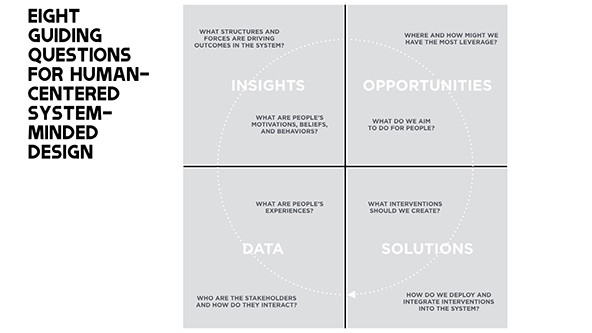
A key to benefitting from both human-centered and systems thinking methods is moving back and forth between the two. One lens may answer new questions we discovered through the other lens. (For example, we might understand an unexpected pattern we noticed through mapping cause-and-effect in the system by hearing individuals’ stories and realizing how their actions drive that pattern.) Deep understanding and attention toward specific people becomes contextualized and evaluated within the larger picture. The understanding of forces and relationships in the system is matched with the beliefs and behaviors of the people in the system.
Tackling tough questions requires a willingness to question assumptions, discover new possibilities, and experiment to see what works. We can make our practice better suited to take on the meaningful, social, and complex challenges of today by combining the human, intuitive, and exploratory nature of human-centered design with the relational, leverage-minded, and strategic nature of systems thinking.
Just ask Vialet. Her design work helped her found Substantial Classrooms in 2016. The organization is currently working to rethink student time with subs, by focusing on products and services that help school districts better train and support subs themselves.
By adopting a design approach, Vialet was able to see the challenge at both the human and systems level. Complex challenges often require this kind of dual mindset and the ability to move fluidly between the two. What some may see as two disparate or conflicting fields might actually function best when used together.
Support SSIR’s coverage of cross-sector solutions to global challenges.
Help us further the reach of innovative ideas. Donate today.
Read more stories by Thomas Both.

